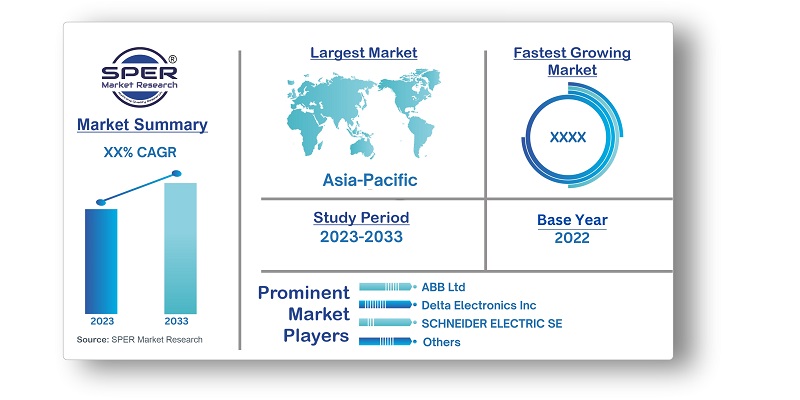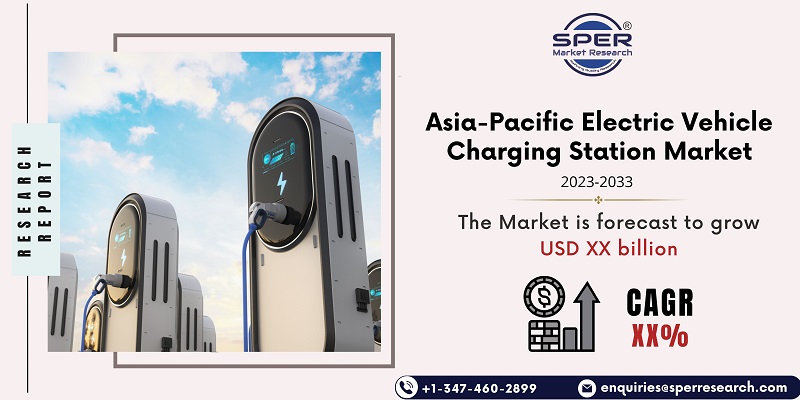
Asia Pacific EV Charging Station Market Growth, Size, Trends, Revenue, Share and Future Outlook
Asia Pacific Electric Vehicle Charging Station Market Size- By Vehicle Type, By Charger Type, By Application- Regional Outlook, Competitive Strategies and Segment Forecast to 2033
| Published: Jan-2024 | Report ID: AMIN2423 | Pages: 1 - 156 | Formats*: |
| Category : Automotive & Transportation | |||
- July 2023: Volkswagen AG announced a large 110 million USD investment to build China's infrastructure for charging stations. The firm and CAMS New Energy Technology (CAMS) established a strategic alliance to lead the nation's charging station initiative.
- September 2022: The well-known Australian company Tritium, which makes the hardware for DC EV chargers on highways, recently revealed its grand proposal to supply Electric Vehicle Supply Equipment (EVSE) for a massive 7,000-kilometer charging corridor project in Western Australia. This project is one of the biggest EV infrastructure projects in the world.


| Report Metric | Details |
| Market size available for years | 2019-2033 |
| Base year considered | 2022 |
| Forecast period | 2023-2033 |
| Segments covered | By Vehicle Type, By Charger Type, By Application |
| Regions covered | China, India, Japan, South Korea, Rest of Asia-Pacific |
| Companies Covered | ABB Ltd., Charzer Tech Pvt Ltd., Delta Electronics Inc., Exicom Telesystems Ltd., Kinetic Green Energy and Power Solutions Ltd, SCHNEIDER ELECTRIC SE, Siemens AG, STAR CHARGE, Tata Power Company Limited, TecSo ChargeZone Ltd., Tesla Inc., Toyota Connected Corporation, Others |
- Consumers
- Automobile Manufacturers
- Government and Regulatory Bodies
- Investors and Financial Institutions
- Academic and Research Institutions
- Non-Governmental Organizations (NGOs) and Advocacy Groups
- Insurance Companies
- Smart Cities and Urban Planners
- Transportation and Logistics Companies
- Media and Communication Outlets
| By Vehicle Type: |
|
| By Charger Type: |
|
| By Application: |
|
| By Region: |
|
- Asia-Pacific Electric Vehicle Charging Station Market Size (FY’2023-FY’2033)
- Overview of Asia-Pacific Electric Vehicle Charging Station Market
- Segmentation of Asia-Pacific Electric Vehicle Charging Station Market By Vehicle Type (Commercial Vehicle, Passenger Car)
- Segmentation of Asia-Pacific Electric Vehicle Charging Station Market By Charger Type (AC Charging Station, DC Charging Station)
- Segmentation of Asia-Pacific Electric Vehicle Charging Station Market By Application (Private, Public)
- Statistical Snap of Asia-Pacific Electric Vehicle Charging Station Market
- Expansion Analysis of Asia-Pacific Electric Vehicle Charging Station Market
- Problems and Obstacles in Asia-Pacific Electric Vehicle Charging Station Market
- Competitive Landscape in the Asia-Pacific Electric Vehicle Charging Station Market
- Impact of COVID-19 and Demonetization on Asia-Pacific Electric Vehicle Charging Station Market
- Details on Current Investment in Asia-Pacific Electric Vehicle Charging Station Market
- Competitive Analysis of Asia-Pacific Electric Vehicle Charging Station Market
- Prominent Players in the Asia-Pacific Electric Vehicle Charging Station Market
- SWOT Analysis of Asia-Pacific Electric Vehicle Charging Station Market
- Asia-Pacific Electric Vehicle Charging Station Market Future Outlook and Projections (FY’2023-FY’2033)
- Recommendations from Analyst
1.1. Scope of the report1.2. Market segment analysis
2.1. Research data source2.1.1. Secondary Data2.1.2. Primary Data2.1.3. SPER’s internal database2.1.4. Premium insight from KOL’s2.2. Market size estimation2.2.1. Top-down and Bottom-up approach2.3. Data triangulation
4.1. Driver, Restraint, Opportunity and Challenges analysis4.1.1. Drivers4.1.2. Restraints4.1.3. Opportunities4.1.4. Challenges4.2. COVID-19 Impacts of the Asia-Pacific Electric Vehicle Charging Station Market
5.1. SWOT Analysis5.1.1. Strengths5.1.2. Weaknesses5.1.3. Opportunities5.1.4. Threats5.2. PESTEL Analysis5.2.1. Political Landscape5.2.2. Economic Landscape5.2.3. Social Landscape5.2.4. Technological Landscape5.2.5. Environmental Landscape5.2.6. Legal Landscape5.3. PORTER’s Five Forces5.3.1. Bargaining power of suppliers5.3.2. Bargaining power of buyers5.3.3. Threat of Substitute5.3.4. Threat of new entrant5.3.5. Competitive rivalry5.4. Heat Map Analysis
6.1. Asia-Pacific Electric Vehicle Charging Station Market Manufacturing Base Distribution, Sales Area, Product Type6.2. Mergers & Acquisitions, Partnerships, Product Launch, and Collaboration in Asia-Pacific Electric Vehicle Charging Stations Market
7.1. Asia-Pacific Electric Vehicle Charging Station Market Value Share and Forecast, By Vehicle Type, 2023-20337.2. Commercial Vehicle7.3. Passenger Car
8.1. Asia-Pacific Electric Vehicle Charging Station Market Value Share and Forecast, By Charger Type, 2023-20338.2. AC Charging Station8.3. DC Charging Station
9.1. Asia-Pacific Electric Vehicle Charging Station Market Value Share and Forecast, By Application, 2023-20339.2. Private9.3. Public
10.1. Asia-Pacific Electric Vehicle Charging Station Market Size and Market Share
11.1. Asia-Pacific Electric Vehicle Charging Station Market Size and Market Share By Vehicle Type (2019-2026)11.2. Asia-Pacific Electric Vehicle Charging Station Market Size and Market Share By Vehicle Type (2027-2033)
12.1. Asia-Pacific Electric Vehicle Charging Station Market Size and Market Share By Charger Type (2019-2026)12.2. Asia-Pacific Electric Vehicle Charging Station Market Size and Market Share By Charger Type (2027-2033)
13.1. Asia-Pacific Electric Vehicle Charging Station Market Size and Market Share By Application (2019-2026)13.2. Asia-Pacific Electric Vehicle Charging Station Market Size and Market Share By Application (2027-2033)
14.1. Asia-Pacific Electric Vehicle Charging Station Market Size and Market Share By Region (2019-2026)14.2. Asia-Pacific Electric Vehicle Charging Station Market Size and Market Share By Region (2027-2033)14.3. China14.4. India14.5. Japan14.6. South Korea14.7. Rest of Asia-Pacific
15.1. ABB Ltd.15.1.1. Company details15.1.2. Financial outlook15.1.3. Product summary15.1.4. Recent developments15.2. Charzer Tech Pvt Ltd.15.2.1. Company details15.2.2. Financial outlook15.2.3. Product summary15.2.4. Recent developments15.3. Delta Electronics Inc.15.3.1. Company details15.3.2. Financial outlook15.3.3. Product summary15.3.4. Recent developments15.4. Exicom Telesystems Ltd.15.4.1. Company details15.4.2. Financial outlook15.4.3. Product summary15.4.4. Recent developments15.5. Kinetic Green Energy and Power Solutions Ltd15.5.1. Company details15.5.2. Financial outlook15.5.3. Product summary15.5.4. Recent developments15.6. SCHNEIDER ELECTRIC SE15.6.1. Company details15.6.2. Financial outlook15.6.3. Product summary15.6.4. Recent developments15.7. Siemens AG15.7.1. Company details15.7.2. Financial outlook15.7.3. Product summary15.7.4. Recent developments15.8. STAR CHARGE15.8.1. Company details15.8.2. Financial outlook15.8.3. Product summary15.8.4. Recent developments15.9. Tata Power Company Limited15.9.1. Company details15.9.2. Financial outlook15.9.3. Product summary15.9.4. Recent developments15.10. TecSo ChargeZone Ltd15.10.1. Company details15.10.2. Financial outlook15.10.3. Product summary15.10.4. Recent developments15.11. Tesla Inc.15.11.1. Company details15.11.2. Financial outlook15.11.3. Product summary15.11.4. Recent developments15.12. Toyota Connected Corporation15.12.1. Company details15.12.2. Financial outlook15.12.3. Product summary15.12.4. Recent developments15.13. Others
SPER Market Research’s methodology uses great emphasis on primary research to ensure that the market intelligence insights are up to date, reliable and accurate. Primary interviews are done with players involved in each phase of a supply chain to analyze the market forecasting. The secondary research method is used to help you fully understand how the future markets and the spending patterns look likes.
The report is based on in-depth qualitative and quantitative analysis of the Product Market. The quantitative analysis involves the application of various projection and sampling techniques. The qualitative analysis involves primary interviews, surveys, and vendor briefings. The data gathered as a result of these processes are validated through experts opinion. Our research methodology entails an ideal mixture of primary and secondary initiatives.



Frequently Asked Questions About This Report
PLACE AN ORDER
Year End Discount
Sample Report
Pre-Purchase Inquiry
NEED CUSTOMIZATION?
Request CustomizationCALL OR EMAIL US
100% Secure Payment






Related Reports
Our Global Clients
Our data-driven insights have influenced the strategy of 200+ reputed companies across the globe.




















